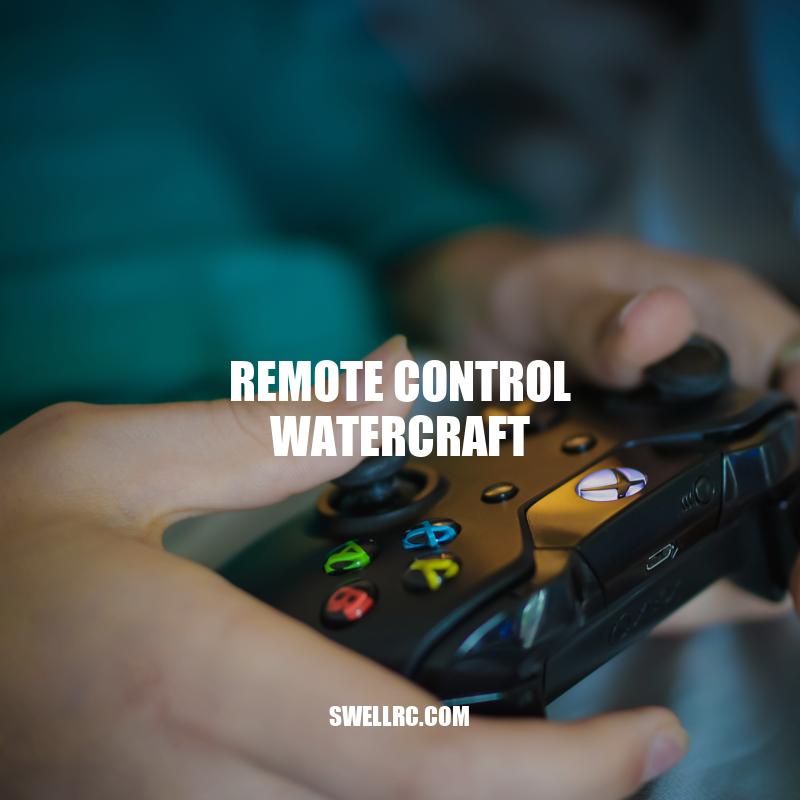Exploring the World of Remote Control Watercraft
Remote control watercraft have been gaining popularity in recent years, becoming a fun and exciting activity for enthusiasts who enjoy playing with remote-controlled toys, as well as those interested in the potential for educational and scientific applications. These toys come in various types, ranging from boats and submarines to hovercraft. They are operated by a small handheld computer radio transmitter that communicates with an onboard receiver, which controls the motor and steering. The techniques for maneuvering remote control watercraft vary across different types, and there are different aspects to consider when choosing one, such as battery life, speed, and durability. For children and adults, these toys can be an excellent way to develop hand-eye coordination, spatial awareness, and other useful skills, and for scientists they can provide unique opportunities for research and experimentation. In this article, we will discuss the different types of remote control watercraft, their components, maintenance, safety, and – in closing – some of the biggest events on the remote control watercraft racing calendar.
Types of Remote Control Watercraft
There are various types of remote control watercraft available on the market, and the choice largely depends on preferences and interests. Some of the popular types are:
- RC Boats: These are the most popular type of remote control watercraft which come in several different shapes and sizes, such as speedboats, sailboats, and warships.
- RC Submarines: These are designed to operate underwater and are ideal for exploring and racing in pools, aquariums, and mountain lakes.
- RC Hovercraft: These watercraft use a cushion of air to move over water surfaces and require less investment than boats or submarines. They are also suitable for a variety of water conditions, including rivers, ponds, and even snow and ice.
Each type has unique features that appeal to a different audience. For instance, RC boats are typically more expensive than other types of watercraft, but they are faster and can handle rougher waters with relative ease. RC submarines, on the other hand, are more popular for those who enjoy exploring and experimenting with underwater devices. The choice ultimately depends on what the user wants to achieve with the device. Those interested in purchasing remote control watercraft can browse online retailers such as Amazon or eBay to find the best products that match their interests and requirements.
What makes a good RC boat?
A good RC boat should have a strong hull, reliable motor, and precise steering controls. The quality of workmanship and materials used are also important factors to consider. Look for boats with waterproof electronics and a good battery life. Brands like Traxxas, Pro Boat, and Aquacraft offer a range of high-quality RC boats with different features and price points. Visit their websites for more information on their products.
Remote control watercraft typically have several essential components that are crucial in their operation. These components include:
- Battery Pack: This is the power source that is responsible for providing energy to the motor, hence facilitating movement.
- Motor: This converts electrical energy from the battery into mechanical energy that drives the watercraft.
- Transmitter: The transmitter is held by the operator and sends commands wirelessly to the receiver on the watercraft.
- Receiver: The receiver is the electronic component responsible for receiving the wireless signals from the transmitter and feeding them into the watercraft’s electric motors.
- Structures: As with all watercraft, there is the hull (body), rudder, and propeller.
Additionally, some advanced remote control watercraft may have GPS systems, cameras, and other sensors that enhance their functionality. Some interesting facts about remote control watercraft components include:
Battery Pack: The type of battery used depends on the size and weight of the watercraft. Generally, lithium-polymer batteries are preferred for remote control watercraft because of their high-energy density, low weight, and low self-discharge rates.
Motor: DC brushed and brushless motors are commonly used in remote control watercraft. Brushless motors are preferred for their higher efficiency, lower noise, and less maintenance requirements.
Transmitter: Advanced transmitters may have programmable settings, such as throttle response, steering rate, and endpoint adjustment, to customize the watercraft’s handling behavior.
Receiver: The most commonly used wireless protocol for remote control watercraft is frequency modulation (FM), which provides a good range and noise immunity. Some watercraft may use digital transmission protocols, such as DSM2, which offer improved reliability and multiple frequency hopping channels.
Structures: The hull shape and design significantly impact the watercraft’s performance and handling characteristics. Deep-vee hulls provide better stability in rough waters, while flat-bottomed hulls have better acceleration and maneuverability.
It is important to ensure that all components are in good condition and working correctly. Generally, maintenance procedures include cleaning, greasing, and tightening any loose components. Retailers such as HobbyKing and Horizon Hobby offer a wide range of remote control watercraft components and accessories that users may purchase to enhance their watercraft’s performances.
What are the components of an RC boat?
The components of an RC boat typically include the hull, motor, propeller, rudder, servo, radio system, battery, and speed controller. Some RC boats may also have additional features such as lights or sound effects. If you are interested in purchasing an RC boat, there are many websites and products available online from hobby shops such as Horizon Hobby or Tower Hobbies.
Skill Level and Safety
Operating remote control watercraft requires a certain skill level and level of responsibility. Here are some things to keep in mind:
- Beginners: It is recommended for beginners to operate on still or calm waters until they get used to how the watercraft behaves.
- Intermediate: The operators should build their skills, such as mastering tight turns and handling the wind.
- Experts: Expert operators of remote control watercraft can perform advanced maneuvers such as jumps, reversals, and cornering at high speeds.
Safety is of utmost importance in remote control watercraft operation, here are some guidelines to follow:
- Never operate remote control watercraft in public swimming pools or near people.
- Always be aware of other boaters and swimmers in the area.
- Wear recommended protective gear, such as a life jacket or wetsuit, to avoid injuries in case of an accident.
- Keep spare batteries and charge them before setting out.
- Check that the watercraft’s components are working correctly before use.
- Be aware of weather conditions and the watercraft’s handling abilities.
- You may need a License or certification depending on your location and the type of watercraft.
Remote control watercraft manufacturers such as Pro Boat and Aquacraft usually provide instruction manuals and relevant information on their websites. There are also communities and forums online where one can find useful tips and tricks for operating and maintaining remote control watercraft safely.
How does a remote control boat work?
A remote control boat works by using a radio transmitter to send signals to a radio receiver on the boat. The radio receiver is connected to two battery-powered electric motors or servos that change the position of the boat’s rudder or propeller. For more information on remote control boats, you can visit websites such as Amazon, HobbyTron, and HorizonHobby.
Maintenance and Repair
Once you have a remote control watercraft, it is essential to know how to maintain and repair it properly. Here are some tips to consider:
- After each use, rinse the watercraft with freshwater to remove salt and other contaminants.
- Clean and dry the components before storage.
- Store the watercraft in a cool and dry place, away from direct sunlight.
- Check the battery charge level before use and replace them if needed.
- Clean the watercraft’s motor, including the cooling system and propeller shaft area.
- Regularly check the remote control to ensure all the buttons and knobs are working correctly.
- If the watercraft stops working correctly, check the battery and controller’s signal frequency.
Repairing a remote control watercraft may not be easy, depending on the issue. Here are some things to keep in mind:
- Avoid attempting to disassemble the watercraft if you do not have the necessary knowledge or equipment.
- Refer to the instruction manual to identify the issue and how to resolve it.
- Search for online forums or communities for advice on how to fix the issue.
- If the watercraft still refuses to work, contact the manufacturer for repair or replacement options.
Remote control watercraft manufacturers such as Traxxas and Kyosho offer spare parts and accessories on their websites to help users maintain or repair their watercraft. However, getting the support of the manufacturer may depend on the warranty policy.
How do remote control boats work?
Remote control boats work by using a radio transmitter to send signals to a radio receiver on the boat. The receiver is connected to battery-powered electric motors or servos that change the position of the boat’s rudder, propelling it forward, turning, or reversing its direction. If you want to know more about remote control boats, you can check out websites like rcboatguide.com or products like the Traxxas Spartan RC Boat.
Competitive Racing
Remote control watercrafts are not only for fun but also for racing competitions. Here are some things to keep in mind to participate in competitive racing:
- Join a remote control watercraft racing club or community, and attend their events and competitions.
- Read the rules and regulations and compete in the appropriate discipline.
- Practice and improve your skills by racing with other members or on your own.
- Choose the appropriate watercraft for the event and modify it if needed.
- Pay attention to the weather conditions, and prepare the watercraft accordingly.
- Attend the race with all necessary equipment such as chargers, spare batteries, and tools.
Remote control watercraft racing is a worldwide phenomenon, and the World Championships are held in different parts of the world, such as Portugal, Italy, and Germany. There are also national-level championships and regional events held worldwide. For instance, in the United States, the International Model Power Boat Association (IMPBA) hosts racing competitions, and their website has race calendars and results.
Several websites and forums provide information about racing events, technical knowledge, and support to remote control watercraft racing enthusiasts. A website like rcgroups.com has a dedicated section for remote control boating with forums on racing, boat building, and troubleshooting. Additionally, websites like HobbyKing and Tower Hobbies provide remote control watercraft products, including boats, submarines, and hovercraft.
What is a remote control boat?
A remote control boat is a miniature or full-size watercraft that can be controlled from a distance using a handheld transmitter. These boats are popular among hobbyists and can be powered by electric, nitro or gas engines. There are also a variety of models available, including racing boats, sailboats, and even submarines. If you are interested in purchasing a remote control boat, there are several websites and online stores that specialize in the sale and distribution of these types of products.
Conclusion
In conclusion, remote control watercraft are more than just toys and can provide endless hours of entertainment for people of all ages. They come in different types and sizes, and there are different levels of skill required to operate them. It is important to keep in mind safety measures when using remote control watercraft, especially in water bodies.
Maintaining and repairing remote control watercraft may seem daunting for some, but proper care can increase the lifespan of the watercraft, and there are several communities and websites ready to assist you in this regard. Remote control watercraft racing is also a popular activity among enthusiasts, and competitive racing events are held worldwide.
If you are thinking of investing in a remote control watercraft, consider the options in the market, and choose the one that aligns with your interests and skill level. Whether it is for casual play or competitive racing, remote control watercrafts can add a new level of excitement and fascination to your leisure time.



